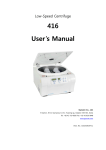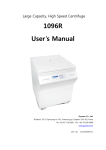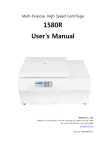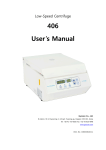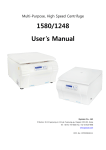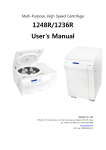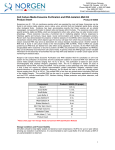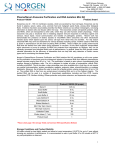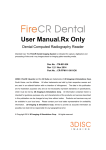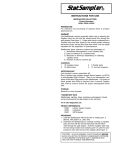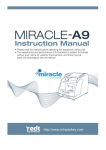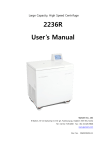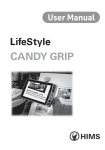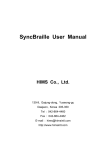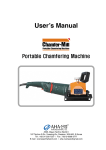Download mini User`s Manual
Transcript
Personal Microcentrifuge mini User’s Manual Gyrozen Co., Ltd. B-station, 30-12 Gyeryong-ro 141-gil, Yuseong-gu, Daejeon 305-301, Korea Tel: +82-42-719-8200 Fax: +82-42-826-9848 www.gyrozen.com DOC. No.: C01DC00204-11 MicroCentrifuge, mini 2 MicroCentrifuge, mini 3 CONTENTS Page # 1. Meanings of Symbols & Safety Precautions ............................................................................................................................... 6 1-1. Meanings of Symbols ....................................................................................................................................................................... 6 1-2. Safety Precautions .............................................................................................................................................................................. 6 2. Product Description & Technical Specifications ..................................................................................................................... 8 2-1. Product Description ........................................................................................................................................................................... 8 2-2. Technical Specifications ................................................................................................................................................................... 9 3. Installation .................................................................................................................................................................................................... 9 3-1. Power on/off and Door Release.................................................................................................................................................... 9 3-2. Rotor Coupling and Disassembling ...........................................................................................................................................10 3-3. Positioning of Sample Tubes ........................................................................................................................................................11 4. Operation ....................................................................................................................................................................................................12 4-1. Key Functions of Control Panel .................................................................................................................................................12 4-2. Setting RPM/RCF.................................................................................................................................................................................13 4-3. Setting Time ..........................................................................................................................................................................................14 4-4. Start/Stop................................................................................................................................................................................................14 4-5. Pulse ..........................................................................................................................................................................................................14 4-6. Emergency Door Open ....................................................................................................................................................................14 5. Maintenance ..............................................................................................................................................................................................15 5-1. Outer part of Instrument ..............................................................................................................................................................15 5-2. Chamber ...............................................................................................................................................................................................15 5-3. Shaft ........................................................................................................................................................................................................15 5-4. Rotor .......................................................................................................................................................................................................15 5-5. Transportation of Instrument........................................................................................................................................................15 6. Trouble Shooting 6-1. ..................................................................................................................................................................................16 Check List .............................................................................................................................................................................................16 MicroCentrifuge, mini 4 6-2. Error Code ..............................................................................................................................................................................................17 7. Rotors & Accessories ............................................................................................................................................................................18 8. Product Range .........................................................................................................................................................................................19 9. CE .................................................................................................................................................................................................................20 MicroCentrifuge, mini 5 1. Meanings of Symbols & Safety Precautions 1-1. Meanings of Symbols 1-1-1. Symbols on the device Symbol Meaning Symbol Indicate a hole for Meaning Attention and warning manual door opening in for electric shock case of emergency Attention and warning Attention and warning for door opening and for rotor coupling. closing 1-1-2. Symbols in this document Symbol Meaning This symbol refers to safety relevant warnings and indicates possible dangerous outcomes. Symbol ☞ Meaning Note. This symbol refers to the important reminder. 1-2. Safety Precautions Before using the instrument, please read this operation manual to ensure correct usage through understanding. Incorrect handling of the instrument could possibly result in personal injury or physical damage on the instrument or its accessories. 1. ALWAYS locate the instrument on a flat, rigid and stable table capable of withstanding the weight of the instrument and its spinning operation. 2. ALWAYS make a safety zone of 30 cm around the centrifuge to indicate that neither hazardous materials nor persons should be permitted within the area during operation. ALWAYS position the instrument with enough space on each side of instrument to ensure MicroCentrifuge, mini 6 proper air circulation. 3. ALWAYS install the instrument within a temperature and humidity controlled environment. (Permissible ambient temperature: +5°C ~ +35 °C, Relative humidity: ≤ 85%) 4. Before connecting the power, check the rated voltage. 5. Should not use unapproved rotors and associated accessories. Only use rotors from Gyrozen Co., Ltd. with appropriate centrifugal tubes and suitable adaptors to embrace sample containers tightly enough inside rotors. 6. Before operating the instrument, check if the rotor and the rotor lid are securely fastened. Should operate the instrument with a rotor properly installed and secured to the motor shaft. 7. Mount the rotor on the motor shaft properly, check it with spinning manually. 8. Do not stop the rotor by touching with hand during the instrument is running. 9. Emergency door open should be performed only when spinning is completely stopped. 10. Should not exceed the rated speed or specific gravity. Samples whose density is greater than 1.2g/ml must have reduced maximum rotational speed to avoid rotor failure. 11. The sample content should not exceed 80% of total capacity of a tube. Otherwise, it would cause spillage of sample fluid and even the tube breakage. 12. ALWAYS load the tubes symmetrically with evenly weighted samples to avoid rotor imbalance. If necessary, use the water blank to counterbalance the unpaired sample. 13. The operation speed should not exceed the highest value of the individual guaranteed g-forces of each centrifuge, rotor, bucket or adaptors and sample container, especially the guaranteed g-force of sample container should not be neglected. 14. The rotors should be cleaned and kept dry after every use for longer life and safety. 15. ALWAYS disconnect the power supply prior to maintenance care and service to avoid electrical shock. 16. ALWAYS use proven disinfection procedures after centrifuging biohazardous materials. 17. Should not centrifuge flammable, toxic, radioactive, explosive, or corrosive materials. 18. When it is necessary to use toxic or radioactive materials or pathogenic micro-organisms which belong to the Risk Group II of WHO: “Laboratory Bio- safety Manual,” should follow national regulations. MicroCentrifuge, mini 7 Do not place dangerous materials within 30 cm distance around the instrument, and that is also recommended by IEC 61010-2-020. Use the emergency door open function only when the door button on the control panel is dumb under the condition of complete stop of rotor running. Never try to open or move the instrument if it is not completely stopped. If the power input is more than +/- 10% of the recommended voltage or fluctuates frequently, it may cause malfunction of the instrument and often result serious damage. Install the instrument at the place without any kinds of corrosive gases. 2. Product Description & Technical Specifications 2-1. Product Description Cat No. GZ-1312, Microcentrifuges includes Fixed Angle rotor GRF-m2.0-12 and 12 of 0.2ml & 0.5ml adaptors. The PCR tube rotor is optional. MicroCentrifuge, mini 8 2-2. Technical Specifications Max. RPM/RCF Max. capacity 13,500 rpm/ 12,300 xg 6,000 rpm/ 1,850 xg (GRF-m2.0-12) (GRA-s0.2-32) 12 x 2.0 ml tubes 4 x 8-tube PCR strips Time control Pulse or timed ≤ 30 min RPM/RCF conversion Yes Noise level(dB) ≤56 Acc/Dec(sec) ≤ 12 / < 16 Display Blue LCD Automatic door release at completion Yes Power supply(V/Hz) 220/50~60 (110V optional) Power requirement(VA) 110 Dimension(W x D x H, mm) 208 x 245 x 145 Weight without rotor (Kg) 4.4 CE mark Yes Cat. No. GZ-1312 3. Installation 3-1. Power On/Off and Door Release Action 3-1-1. Power On/Off 1. Connect the AC Power cord at the power socket on the back of the instrument. 2. Turn on the instrument by pressing a switch on the back of the instrument. 3. Press the ‘Door’ button to open the door. MicroCentrifuge, mini 9 3-1-2. Door Release 1. For opening the door, press the [DOOR] button. The door is automatically opened after completion of spinning operation with beeping sound. When you close the door, close it until hearing clank shut. The door is not opened while the instrument is running. ☞ If the door is opened, the instrument could not be operated even with pressing the ‘Start’ button. Power Failure: If there is any power failure during the operation, door is not opened with ‘Door’ button. Door can be opened only when the operation is completely stopped and the power is on again. If you want to open the door at the power failure, please refer to ‘4-6. Emergency Door Open’. 3-2. Rotor Coupling and Disassembling Action 1. Before coupling a rotor, clean the motor shaft and chamber with soft dry towel. 3-2-1. Fixed Angle Rotor 1. Mount a proper rotor into the motor shaft. 2. Place the Rotor Locking Nut at the center hole of the rotor. To assemble the rotor: Rotate the Rotor Locking Nut clockwise until tightly assembled. To disassemble the rotor: Rotate the Rotor Locking Nut counterclockwise. 3. After loading sample tubes, close the rotor lid until hearing clank shut. When you open the lid, lift the nut. MicroCentrifuge, mini 10 3-2-2. PCR Rotor 2. Mount the PCR rotor into the motor shaft. 3. Place the Rotor Locking Nut at the center hole of rotor. To assemble the rotor: Rotate the Rotor Locking Nut clockwise until tightly assembled. To disassemble the rotor: Rotate the Rotor Locking Nut counterclockwise. When the PCR rotor is coupled, please do not speed over 6,000 rpm/2,400 rcf. 3-3. Positioning of Sample Tubes Action 1. Before loading sample tubes, check the water drop or dirt in the rotor hole or inner adaptor. If there is a water drop or dirt in the rotor hole or inner adaptor, remove it with soft dry cloth. 2. Tubes should be placed in the rotor with same amount of samples at symmetrical positions. Only use appropriate centrifugal tubes and do not exceed the speed beyond the tube’s max g-force. For safety, fill the sample for 70~80% in the tubes. Correct Ways of Sample Balancing & Tube usage ☞ If the number of samples is not in pair, please load the control tubes at each symmetrical position. Otherwise, it results noise and vibration, which eventually damage the instrument. MicroCentrifuge, mini 11 4. Operation 4-1. Key Functions of Control Panel Display Window Shows speed, time, status of running and the status of door opening or closing. RPM/RCF Modes are displayed as rpm and rcf. While running, appears when the Door is opened and is flickering. appears when the Door is closed. Time is displayed as ‘min’ Setting Buttons When setting up the RPM/RCF and Time, you can put the set value with up (▲) and down (▼) button. Function Buttons Door For opening instrument door Pulse For quick spin down Start/Stop Commend start and stop operation MicroCentrifuge, mini 12 4-2. Setting RPM/RCF ▶ Maximum RPM/RCF: 13,500 RPM/ 12,300 x g ▶ Display value: multiply 1,000 to check real value. (Example: RPM Display value 13.5 indicates RPM 13,500) Action 4-2-1. Setting RPM 1. 2. Press the [RPM/RCF] button once. RPM MODE is generated by pressing a [RPM/RCF] button once. RPM LED is flickering on the display window. Press the [▲▼] buttons to change input value. RPM setting unit: 0.1 unit (0.1=100rpm) After 5 seconds from pressing the input value, the setting value is saved. If you want to check the input value, press [RPM/RCF] button. If you do not press the [▲▼] button for 5 seconds, the setting mode is cleared. 4-2-2. Setting RCF 1. 2. Press a [RPM/RCF] button twice. RCF MODE is generated by pressing a [RPM/RCF] button twice. RCF LED is flickering on the display window. Press the [▲▼] buttons to change input value. RCF setting unit: 0.1 unit (0.1=100 rcf) After 5 seconds from pressing the input value, the If you want to check the input value, press [RPM/RCF] button. If you do not press the [▲▼] button for 5 seconds, the setting mode is setting value is saved. cleared. When the PCR rotor is coupled, please keep in mind that do not over speed at the max. 6,000 rpm/2,400 rcf. MicroCentrifuge, mini 13 4-3. Setting Time ▶ Time control: 1 min. ~30 min. ▶ Time setting unit: 1min. Action 1. Press the [TIME] button once. ‘min’ on LED is flickering. 2. Press the [▲▼] buttons to change input value. After 5 seconds from pressing the input value, the setting value is saved. If you do not press the [▲▼] button for 5 seconds, the setting mode is cleared. 4-4. Start/Stop Action 1. After setting RPM/RCF and Time, press [Start/STOP] button. The running starts only when the door is closed. In case of pressing the [Start /Stop] button while running, the running is stopped. 4-5. Pulse ▶ It is for quick spin down. Action 1. If you press ‘Pulse’ button and release at the point you want to stop, the centrifuge decelerates immediately. When the running is stopped, the door is opened automatically with beeping sound. 4-6. Emergency Door Open The door can be unlocked manually with Emergency Door Open Function. 1. After pulling the instrument forward about 10cm, find the “Emergency Door Open Hole” at the bottom of the instrument 2. Insert spikes (a car key, scissors and etc.) 2~3cm into the “Emergency Door Open” hole and pull the spikes at the opposite direction of the arrow. MicroCentrifuge, mini 14 Manual opening should be performed only when spinning is completely stopped. Otherwise, harmful damage will be accompanied to not only operators but samples. After opening the door manually, it is recommended to wait until normal electricity comes back. 5. Maintenance 5-1. Outer part of Instrument 1. Clean the outside of the instrument with dry soft cloth. If necessary, dip the cloth in neutral detergent and clean contaminated area. Keep completely dry after cleaning. 2. Do not use any volatile chemicals such as alcohol and benzene, etc. 3. Be careful not to make scratches on the surface of the instrument. The scratches can cause corrosion on the surface of the instrument. If any rust appears, clean it with neutral detergents and keep dry. 5-2. Chamber 1. Keep dry inside the chamber after every use. 2. If the chamber is contaminated, dip the cloth in neutral detergent and clean contaminated area. 5-3. Shaft 1. Always make special attention to clean the motor shaft to avoid any imbalance problem due to the contaminants. 2. After using the instrument, take out the rotor from the shaft, and clean the shaft with dry soft cloth to keep dry. 5-4. Rotor 1. If any parts are contaminated with samples, clean the rotor with soft wet cloth and keep the rotor dry. 2. Be careful not to make scratches inside or on the surface of rotors. Any small scratches can cause corrosion of the rotor and big damage to the instrument. 3. If you do not use the instrument, keep the rotor separately from the motor shaft and stand it upside down. 5-5. Transportation of Instrument 1. If you need to move or ship the instrument, be cautious to protect the motor shaft from any physical impact or turbulence. 2. Do not mount a rotor in any cases of movement. Fill inside the chamber with proper materials to keep the motor shaft on place and not to be influenced by physical pressure. MicroCentrifuge, mini 15 6. Trouble Shooting 6-1. Check List Symptom Check list Connect the AC Power cord and make sure that the line is completely Power failure connected between the instrument and power outlet. Check the power switch is turned on. (Please refer to 3-1. Power On/Off) Can’t be started If the door is not closed completely, the instrument can’t run. Check the Door LED on the display window and close the door completely. If the power is out, check the main fuse for the laboratory to supply the Can’t open the door power. If it is not solved in shortly, open the door with spikes for safety of sample. (Please refer to 4-6. Emergency Door Open) Remove the dirt at the door latch and then close the door completely Can’t close the door again. If the door seems not being closed by mechanical reason, please contact our service team. Please check the balanced status of both the table and the instrument. Please re-check the coupling status of the following three matches to minimize the noise Noise and vibration during running 1. the balanced way of coupling of the rotor into the motor shaft 2. the completeness of fixing of the Rotor Locking Nut on the rotor 3. the matching status of Rotor Lid with the rotor Check balances of samples in the rotor. (Please refer to 3-3. Positioning of Sample Tubes) and load the same weight of samples symmetrically. MicroCentrifuge, mini 16 6-2. Error code If the instrument shows the error code with beeping sound, press ‘STOP’ button to stop the beeping sound and press ‘Enter’ button to release of the error status and make the instrument go to the default setting again. Error Possible Causes Actions - Shut off the power supply, and then, turn on the power switch again Error 1 or Error 9 to check the instrument. RPM Sensor - If the error code shows continuously although you try to operate again, please call Gyrozen Field Service Engineer. - If the door is not closed completely, this message is appeared. - Remove the dirt at the door latch and then close the door completely Error 2 Door again. Check the Door LED on the display window. If it is not solved in shortly, open the door with emergency door tool manually for safety of sample. (Please refer to 4-6. Emergency Door Open.) - If the motor is overheated, this message is appeared. - Shut off the power supply for an hour, and then turn on the power Error 3 Motor Overheating switch for checking the instrument. - If the error code shows continuously, please call Gyrozen Field Service Engineer. - If the power input of Power supply (V/Hz) is 10% less than required power, this message is appeared. Error 4 Low Voltage - Shut off the power supply and then check the voltage of the Power supply (V/Hz). - Use AVR to provide proper power. - If the power input of Power supply (V/Hz) is 10% more than required power, this message is appeared. Error5 High Voltage - Shut off the power supply and then check the voltage of the Power supply (V/Hz). - Use AVR to provide proper power. Error 6 Over Speed - If the instrument is spun with over speed, there will be some problems in the overload of motor and the output of motor. MicroCentrifuge, mini 17 - Shut off the power supply, and then, turn on the power switch again to check the instrument. - If the installed software has bugs, this message is appeared. Error 7 Software Error 8 Imbalance - Tuning the firmware (Download)* - Check weight-balances of samples (Please refer to 3-3. Positioning of Sample Tubes) and then turn off and on the instrument for checking. * Any wire disconnection or tuning of the instrument must be performed only by a service engineer who is authorized by GYROZEN Co., Ltd. 7. Rotors and Accessories MicroCentrifuge, mini 18 8. Product Range MicroCentrifuge, mini 19 9. CE MicroCentrifuge, mini 20




















